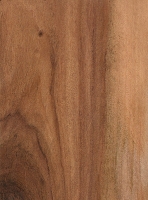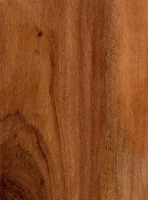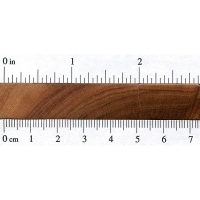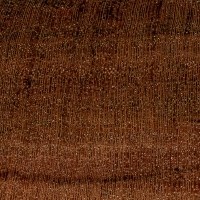 |
Common Name(s): Rhodesian Teak, Zambesi Redwood Scientific Name: Baikiaea plurijuga Distribution: Primarily Zimbabwe (formerly Rhodesia) and other countries in southern Africa Tree Size: 50-65 ft (15-20 m) tall, 1-2 ft (.3-.6 m) trunk diameter Average Dried Weight: 56 lbs/ft3 (890 kg/m3) Specific Gravity (Basic, 12% MC): .73, .89 Janka Hardness: 2,990 lbf (13,300 N) Modulus of Rupture: 12,220 lbf/in2 (84.3 MPa) Elastic Modulus: 1,230,000 lbf/in2 (8.48 GPa) Crushing Strength: 9,600 lbf/in2 (66.2 MPa) Shrinkage: Radial: 2.6%, Tangential: 4.5%, Volumetric: 6.9%, T/R Ratio: 1.7 |
Color/Appearance: Heartwood is a medium reddish brown, commonly with black streaks. Sharply defined sapwood is a pale pinkish yellow.
Grain/Texture: Grain is straight to interlocked, with a fine, even texture and low natural luster.
Endgrain: Diffuse-porous; solitary and radial multiples; small to medium pores in no specific arrangement, moderately numerous; yellowish brown mineral/gum deposits present; parenchyma vasicentric, banded; narrow to medium rays, spacing normal to fairly close.
Rot Resistance: Rated as very durable; good insect resistance, though sapwood is prone to insect attack.
Workability: Can be difficult to work because of high cutting resistance—saws slowly, and has a tendency to ride up over jointer knives. Also, due to its high silica content, cutting edges become severely blunted. However, the wood is stable in service, and glues, turns, and finishes well.
Odor: No characteristic odor.
Allergies/Toxicity: Although severe reactions are quite uncommon, Rhodesian Teak has been reported cause respiratory irritation. See the articles Wood Allergies and Toxicity and Wood Dust Safety for more information.
Pricing/Availability: Although Rhodesian Teak is an important timber, it’s not commonly exported. It’s sometimes available as flooring or as narrow boards; expect prices to be in the mid to upper range for an imported hardwood.
Sustainability: This wood species is not listed in the CITES Appendices, but is reported by the IUCN as being near threatened. Technically it doesn’t meet the Red List criteria of a vulnerable or endangered species, but is close to qualifying and/or may qualify in the near future.
Common Uses: Flooring, veneer, millwork, fretboards, and turned objects.
Comments: Despite it’s common name, this wood species is not a true Teak (Tectona genus). However, much like genuine Teak, it does have good stability and rot resistance, and is considerably harder than genuine Teak.
Rhodesian Teak’s difficult workability is a two-edged sword: the very same cutting resistance also translates to excellent wear-resistance in service, making it well suited for use as flooring or guitar fretboards. Luthiers sometimes refer to this wood as Mukushi or Zambian Teak.
None available.
None available.








Hi can dowel sticks be used on Rhodesian teak wood chairs instead of screws.
Why i am asking my chairs become wobling the screws start to come loose, now i need to make the chair more stable, cannot tight the screws because the wood is to dry when i tight it , the wood start to crack.
Need advice please.
Thank you so so much
Lived in Zambia when I was young and my father took alot of this home. From decommissioned colonial era railway sleepers. These sleepers that have been on and in the ground are perfect condition. Super tough. Ive made floating shelves for the bathroom. Practically an ideal wood. Super tough and resistant to any form of rot or fungal stuff. Absolutely stunning when oiled. A blend of red and black streaks. Very nice for knife handles as well. Although they’re very time consuming to file and polish as it gunks up in the file and sabdpaper. But I’d imagine they’d machine… Read more »
What did you use to oil the wood? I am currently looking into buying some flooring second hand and I am curious what the wood looks like when oiled rather than poly-urethaned. (urrgggh) I am based in South Africa
The hardness of this wood is very weird, I’ve came across steel nails softer than this wood.
I know isn’t the hardest woods by the numbers.
But is very tuff to work with.
My advice is, if you work with this wood , you going to need fresh sharp blades,fresh knifes, fresh sandpaper.
The elasticity doesn’t seem correct. This is really hard, really heavy wood and yet it is rated 8.48. That must be an error.
It does seem low but it comes from PROTA, a pretty reliable source. https://www.prota4u.org/database/protav8.asp?h=M4&t=Baikiaea,plurijuga&p=Baikiaea+plurijuga#Synonyms
But it’s still a single source and I’d feel better if there were another source to compare to.